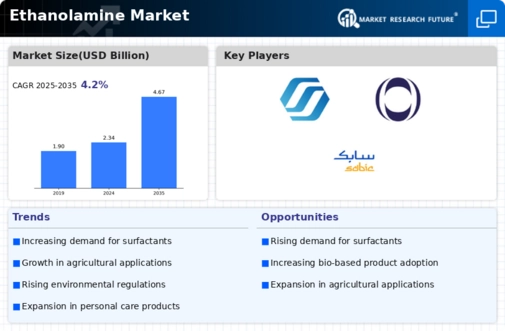Market Analysis
In-depth Analysis of Ethanolamine Market Industry Landscape
The ethanolamine market dynamics are influenced by various factors that collectively shape its growth patterns and trends. Here's a breakdown of key points outlining these dynamics:
Wide Range of Applications: Ethanolamines are versatile chemicals used in various industries, including agriculture, personal care, pharmaceuticals, textiles, and chemical manufacturing. Their diverse applications, ranging from surfactants and corrosion inhibitors to solvents and gas treatment agents, contribute to stable demand and market growth.
Growing Demand in Agrochemical Sector: Ethanolamines are integral components of herbicides, pesticides, and fungicides used in the agricultural sector. With increasing global population and food demand, there is a growing need for agrochemicals, driving the demand for ethanolamines and influencing market dynamics positively.
Rising Demand for Personal Care Products: Ethanolamines are commonly used in personal care products such as shampoos, soaps, and cosmetics as pH adjusters and emulsifiers. As consumer awareness of personal hygiene and grooming increases, the demand for these products rises, impacting market dynamics in the personal care industry.
Utilization in Gas Treatment Processes: Ethanolamines are utilized in gas treatment processes, particularly in the removal of acidic gases such as carbon dioxide (CO2) and hydrogen sulfide (H2S) from natural gas and refinery streams. The expansion of oil and gas exploration and production activities drives the demand for gas treatment chemicals, influencing market dynamics in the energy sector.
Shift towards Green and Sustainable Solutions: Environmental regulations and sustainability initiatives are driving the adoption of green and sustainable chemicals in various industries. Ethanolamines, with their biodegradable properties and low toxicity, are increasingly preferred over conventional chemicals, impacting market dynamics by catering to eco-conscious consumers and regulatory requirements.
Technological Advancements and Process Innovations: Ongoing research and development efforts have led to technological advancements and process innovations in ethanolamine production. New manufacturing techniques and catalyst technologies are being introduced to improve efficiency, reduce costs, and enhance product quality, shaping market dynamics in the chemical manufacturing sector.
Fluctuations in Raw Material Prices: The prices of raw materials used in ethanolamine production, such as ethylene oxide and ammonia, are subject to fluctuations due to factors like supply-demand dynamics and geopolitical tensions. Changes in raw material prices can impact production costs and influence market dynamics accordingly.
Regulatory Compliance and Safety Standards: Compliance with regulatory standards and safety requirements, such as those set by REACH (Registration, Evaluation, Authorization, and Restriction of Chemicals) and OSHA (Occupational Safety and Health Administration), is essential for ethanolamine manufacturers. Adherence to these standards influences market dynamics by ensuring product quality, safety, and environmental compliance.
Market Consolidation and Competitive Landscape: The ethanolamine market is characterized by intense competition among key players striving to gain market share through product differentiation, geographic expansion, and strategic alliances. Market consolidation through mergers, acquisitions, and partnerships also impacts market dynamics by reshaping the competitive landscape.
Economic Trends and Market Growth: Economic conditions and market growth in key regions influence the demand for ethanolamines. Factors such as GDP growth, industrial production, and investment in infrastructure projects impact market dynamics by driving demand from end-user industries.






Leave a Comment